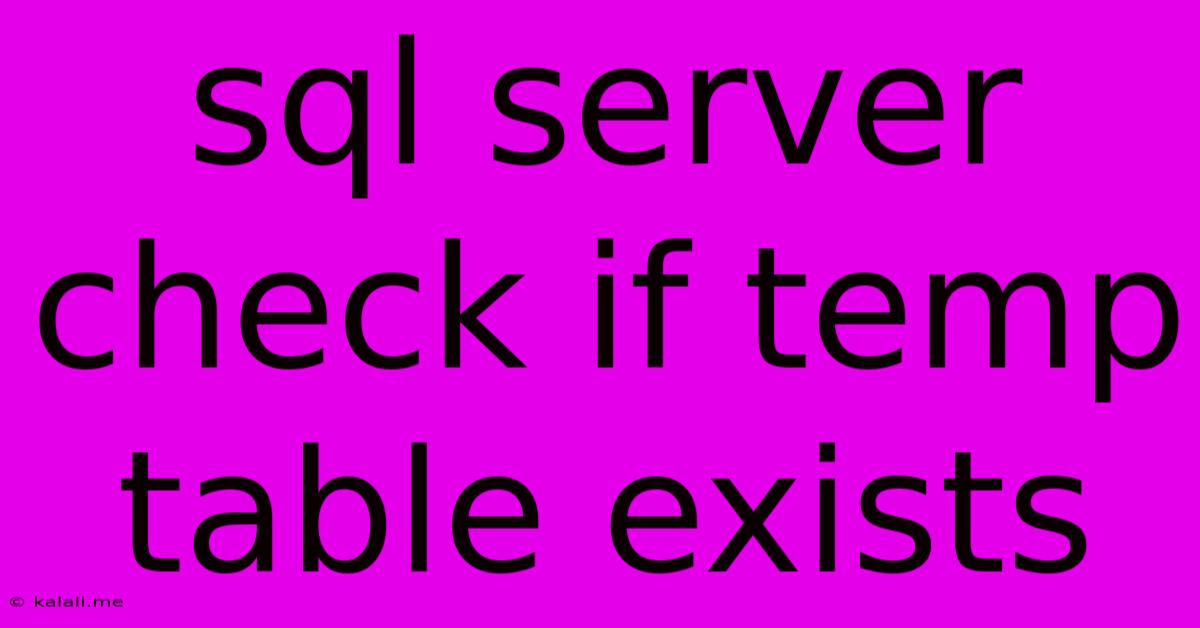Sql Server Check If Temp Table Exists
Kalali
Jun 09, 2025 · 3 min read

Table of Contents
SQL Server: Checking if a Temporary Table Exists
This article will guide you through several methods to check if a temporary table exists in SQL Server. Knowing whether a temporary table already exists is crucial for efficient database management, preventing errors, and ensuring data integrity within your stored procedures and scripts. We'll explore various approaches, each with its pros and cons, allowing you to choose the best technique for your specific scenario. This is essential for robust error handling and preventing unexpected behavior in your database applications.
Before diving into the methods, let's understand the different types of temporary tables in SQL Server:
-
Local Temporary Tables: These tables (#tablename) exist only for the duration of the current session and are automatically dropped when the session ends. They are only visible to the session that created them.
-
Global Temporary Tables: These tables (##tablename) exist for the duration of multiple sessions, but are dropped when the last session referencing them ends. They are accessible to any session that knows their name.
The methods we'll cover apply to both local and global temporary tables, but you need to adapt the table name accordingly.
Method 1: Using OBJECT_ID()
This is arguably the most straightforward and efficient method. The OBJECT_ID() function returns the object ID of a database object if it exists; otherwise, it returns NULL.
IF OBJECT_ID('tempdb..#MyTempTable') IS NOT NULL
BEGIN
-- Temporary table exists, perform actions here
PRINT 'Temporary table #MyTempTable already exists.';
END
ELSE
BEGIN
-- Temporary table does not exist, create it
PRINT 'Temporary table #MyTempTable does not exist. Creating it.';
CREATE TABLE #MyTempTable (
Column1 INT,
Column2 VARCHAR(255)
);
END;
Replace #MyTempTable with the actual name of your temporary table. Remember to include tempdb.. before the table name for local temporary tables. For global temporary tables, omit tempdb...
Advantages: Simple, efficient, and directly checks for the table's existence.
Disadvantages: Requires knowledge of the exact temporary table name.
Method 2: Using sp_help (Less Efficient)
While functional, sp_help is less efficient than OBJECT_ID() for simply checking table existence. It provides a wealth of information about a database object, but this extra information isn't necessary if you only need to know if the table exists.
DECLARE @TableName VARCHAR(255) = '#MyTempTable';
DECLARE @SQL VARCHAR(MAX);
SET @SQL = 'sp_help ''' + @TableName + '''';
EXEC (@SQL);
-- Error handling would be necessary to check if the table actually exists
This method requires careful error handling to determine if the table exists based on the output of sp_help. This is why it's generally less preferred compared to OBJECT_ID().
Method 3: Using a TRY...CATCH Block (For Robust Error Handling)
This method leverages a TRY...CATCH block to handle potential errors when attempting to access the temporary table. If an error occurs (e.g., the table doesn't exist), the CATCH block will execute.
BEGIN TRY
SELECT TOP 1 1 FROM #MyTempTable; -- Attempt to select from the table
-- Table exists, perform actions here
PRINT 'Temporary table #MyTempTable exists.';
END TRY
BEGIN CATCH
-- Table does not exist, handle the error appropriately
PRINT 'Temporary table #MyTempTable does not exist.';
CREATE TABLE #MyTempTable (
Column1 INT,
Column2 VARCHAR(255)
);
END CATCH;
This provides a more robust error-handling mechanism, but it might be slightly less efficient than OBJECT_ID().
Choosing the Right Method
For most situations, the OBJECT_ID() method is the recommended approach due to its simplicity, efficiency, and clarity. The TRY...CATCH method is useful when more sophisticated error handling is required. Avoid using sp_help for this specific purpose as it’s less efficient and requires complex error handling. Remember to always consider the context of your application and choose the method that best suits your needs in terms of performance and error handling. Always prioritize clean, efficient code that is easy to understand and maintain.
Latest Posts
Latest Posts
-
How To Clean Mildew Off Concrete
Jun 09, 2025
-
Is A Brake Fluid Flush Necessary
Jun 09, 2025
-
Is The White Wire The Hot Wire
Jun 09, 2025
-
How To Turn The Boiler On
Jun 09, 2025
-
Json Convert Why Are Keys Uppercase
Jun 09, 2025
Related Post
Thank you for visiting our website which covers about Sql Server Check If Temp Table Exists . We hope the information provided has been useful to you. Feel free to contact us if you have any questions or need further assistance. See you next time and don't miss to bookmark.